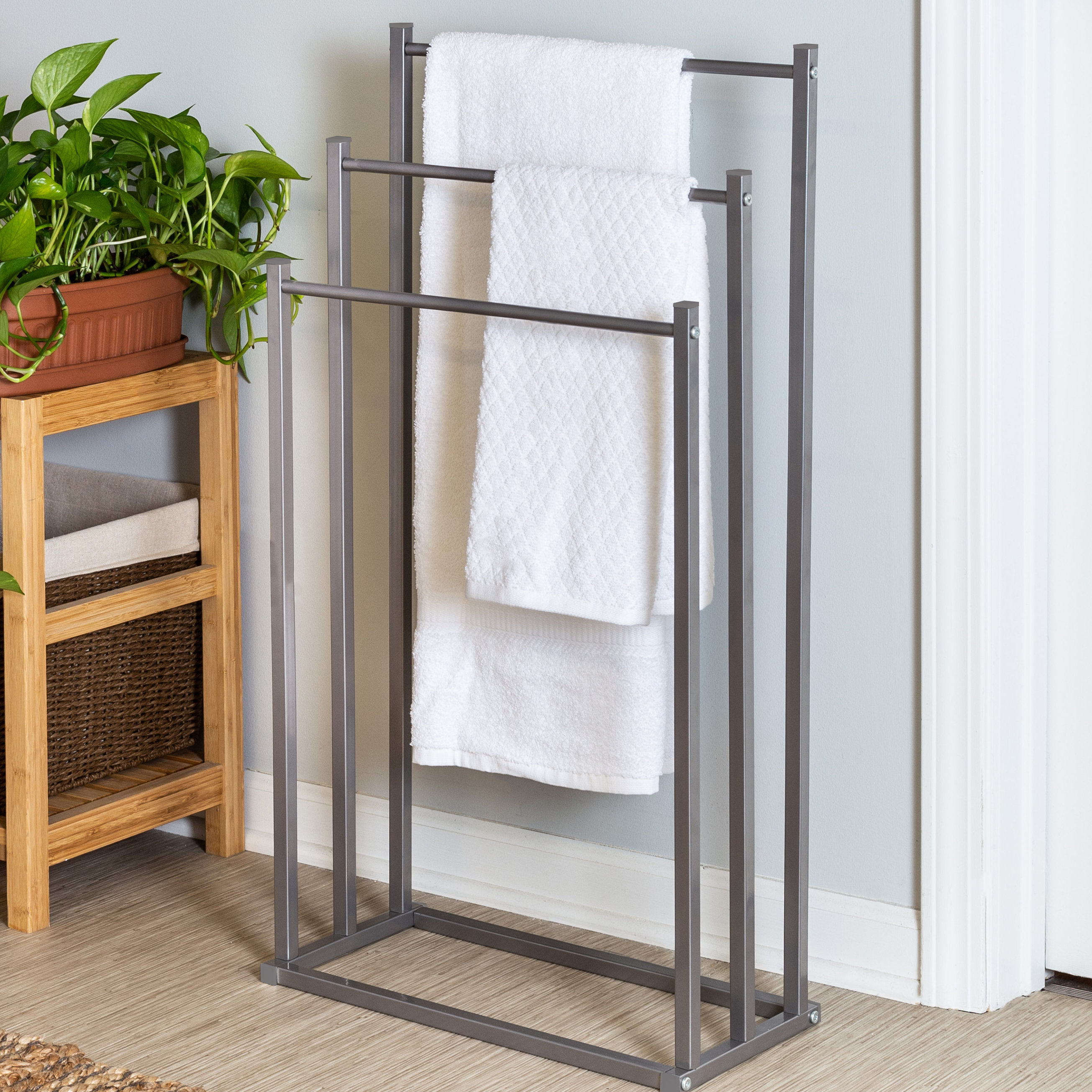Types of Stand-Alone Bathroom Towel Racks

A stand-alone bathroom towel rack is a freestanding structure that provides a dedicated space for drying towels. It’s a versatile solution for bathrooms of all sizes, offering a practical and stylish way to organize your towels. These racks come in various styles and materials, each with unique advantages and disadvantages.
Freestanding Towel Racks
Freestanding towel racks are a popular choice for their versatility and ease of placement. They can be moved around the bathroom as needed, making them ideal for small spaces or for those who prefer a flexible arrangement.
- Advantages: Freestanding towel racks offer flexibility in placement, allowing you to position them wherever you need them. They also don’t require any drilling or installation, making them a great option for renters or those who don’t want to damage their walls.
- Disadvantages: Freestanding towel racks can be less stable than wall-mounted options, especially if they are not weighted down. They also may take up more floor space, which could be a concern in smaller bathrooms.
Wall-Mounted Towel Racks
Wall-mounted towel racks are a more permanent solution that offers a space-saving and sleek look. They are attached directly to the wall, freeing up floor space and creating a streamlined appearance.
- Advantages: Wall-mounted towel racks are incredibly space-saving, as they don’t take up any floor space. They are also generally more stable than freestanding racks, making them a good choice for heavy towels.
- Disadvantages: Wall-mounted towel racks require drilling and installation, which can be a challenge for some people. They are also less flexible than freestanding racks, as they cannot be easily moved once installed.
Rolling Towel Racks, Stand alone bathroom towel rack
Rolling towel racks combine the best of both worlds, offering the convenience of a freestanding rack with the stability of a wall-mounted rack. They are equipped with wheels, allowing you to easily move them around the bathroom as needed.
- Advantages: Rolling towel racks are highly versatile, offering both mobility and stability. They are a good option for those who want the convenience of a freestanding rack but also need a stable solution.
- Disadvantages: Rolling towel racks can be more expensive than other types of towel racks. They can also be bulky, taking up more space than a freestanding rack.
Comparison Table
| Type | Material | Dimensions | Weight Capacity | Price Range |
|---|---|---|---|---|
| Freestanding | Metal, wood, bamboo | Varying, typically 18-24 inches wide | 10-20 lbs | $20-$100 |
| Wall-mounted | Metal, wood, plastic | Varying, typically 12-20 inches wide | 10-30 lbs | $15-$75 |
| Rolling | Metal, wood | Varying, typically 24-36 inches wide | 15-40 lbs | $50-$150 |
Choosing the Right Stand-Alone Towel Rack

Selecting the perfect stand-alone towel rack for your bathroom involves considering various factors to ensure it meets your needs and complements your bathroom’s aesthetic.
Size and Placement
Determining the ideal size and placement of a stand-alone towel rack is crucial for maximizing functionality and minimizing clutter.
- Measure the available space in your bathroom where you intend to place the towel rack. Consider the width, depth, and height of the area, leaving enough room for comfortable movement around the rack.
- Determine the number of towels you need to accommodate. A single towel rack might suffice for a small bathroom, while a multi-tiered rack might be necessary for a larger bathroom or a family.
- Consider the height of the towel rack. It should be placed at a comfortable height for reaching and hanging towels, typically between 40-60 inches from the floor.
- Choose a placement that allows for easy access to the towel rack, ensuring it doesn’t obstruct any doorways or other bathroom fixtures.
Material and Durability
The material used in constructing a stand-alone towel rack significantly influences its durability, aesthetic appeal, and price point.
- Stainless Steel: Known for its durability, rust resistance, and sleek modern look, stainless steel is a popular choice for towel racks. It is generally more expensive than other materials but offers excellent longevity and easy maintenance.
- Chrome: Similar to stainless steel, chrome is highly durable, rust-resistant, and boasts a shiny, reflective finish. Chrome towel racks are often more affordable than stainless steel, making them a budget-friendly option.
- Brass: Brass towel racks offer a classic and elegant look with a warm, golden tone. While durable, brass can be more susceptible to tarnishing over time, requiring occasional polishing. Brass towel racks tend to be pricier than chrome or stainless steel.
- Bamboo: A natural and sustainable material, bamboo is lightweight, durable, and adds a touch of warmth to the bathroom. Bamboo towel racks are typically more affordable than metal options and offer a rustic, eco-friendly aesthetic.
- Wood: Wooden towel racks can provide a classic and elegant look, with various wood types offering different textures and colors. However, wood requires more maintenance than metal, as it can be susceptible to moisture damage.
Functionality and Style
Consider the specific features and design elements that enhance the functionality and style of your stand-alone towel rack.
- Towel Bars: Standard towel racks typically feature horizontal bars for hanging towels. The number of bars depends on the rack’s size and intended use.
- Hooks: Some towel racks include hooks for hanging washcloths, hand towels, or bathrobes. Hooks can be a convenient addition for maximizing storage space.
- Shelves: Towel racks with shelves provide additional storage for toiletries, folded towels, or decorative items.
- Freestanding vs. Wall-Mounted: Stand-alone towel racks are typically freestanding, offering flexibility in placement. However, wall-mounted towel racks can be a space-saving option, particularly in smaller bathrooms.
- Style: Choose a style that complements your bathroom’s décor. Modern bathrooms might prefer sleek, minimalist towel racks, while traditional bathrooms might opt for ornate or vintage designs.
Installing and Maintaining a Stand-Alone Towel Rack: Stand Alone Bathroom Towel Rack

Installing and maintaining a stand-alone towel rack is relatively straightforward, but understanding the specific requirements for each type is crucial. Whether you opt for a freestanding, wall-mounted, or rolling option, the installation process and maintenance needs will differ.
Installing a Stand-Alone Towel Rack
Installing a stand-alone towel rack can be a DIY project. However, the installation process will vary depending on the type of rack you choose.
Freestanding Towel Racks
Freestanding towel racks require minimal installation. They typically stand on their own, without the need for drilling or mounting.
- Unpack and assemble: Carefully unpack the rack and follow the manufacturer’s instructions for assembly. Most freestanding racks come with simple assembly instructions and necessary hardware.
- Position the rack: Choose a suitable location in your bathroom. Ensure the rack is placed on a stable and level surface.
- Adjust the height: Some freestanding racks have adjustable heights. Adjust the rack to your desired height for comfortable towel access.
Wall-Mounted Towel Racks
Wall-mounted towel racks offer a space-saving solution and can be installed in various bathroom areas.
- Mark the mounting points: Use a level to mark the desired location for the rack on the wall. Ensure the marked area is free of obstructions.
- Drill pilot holes: Drill pilot holes at the marked points using a drill bit slightly smaller than the screws provided with the rack.
- Install the mounting hardware: Secure the mounting hardware, such as anchors or brackets, into the drilled holes.
- Attach the rack: Align the rack with the mounting hardware and secure it using the provided screws.
Rolling Towel Racks
Rolling towel racks offer flexibility and mobility, allowing you to move the rack as needed.
- Unpack and assemble: Carefully unpack the rack and follow the manufacturer’s instructions for assembly.
- Position the rack: Choose a suitable location in your bathroom. Ensure the rack is placed on a smooth and even surface.
- Adjust the height: Some rolling racks have adjustable heights. Adjust the rack to your desired height for comfortable towel access.
Maintaining a Stand-Alone Towel Rack
Regular maintenance ensures your towel rack remains functional and aesthetically pleasing.
- Cleaning: Wipe down the rack with a damp cloth and mild soap. Avoid using abrasive cleaners or harsh chemicals that could damage the finish.
- Drying: Thoroughly dry the rack after cleaning to prevent watermarks or rust.
- Lubrication: For rolling racks, lubricate the wheels or casters with a light oil to ensure smooth movement.
- Inspection: Regularly inspect the rack for any loose screws, damaged parts, or rust. Tighten loose screws or replace damaged parts as needed.
